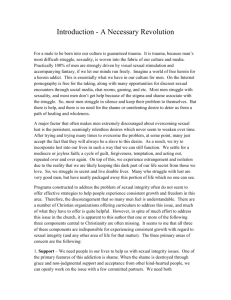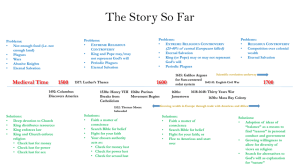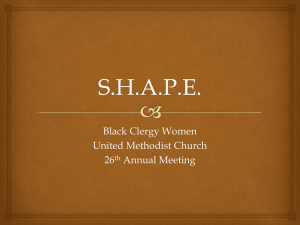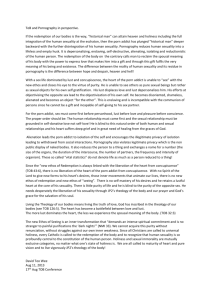"The Effect of Leaking Underground Storage Tanks on the Values of
advertisement
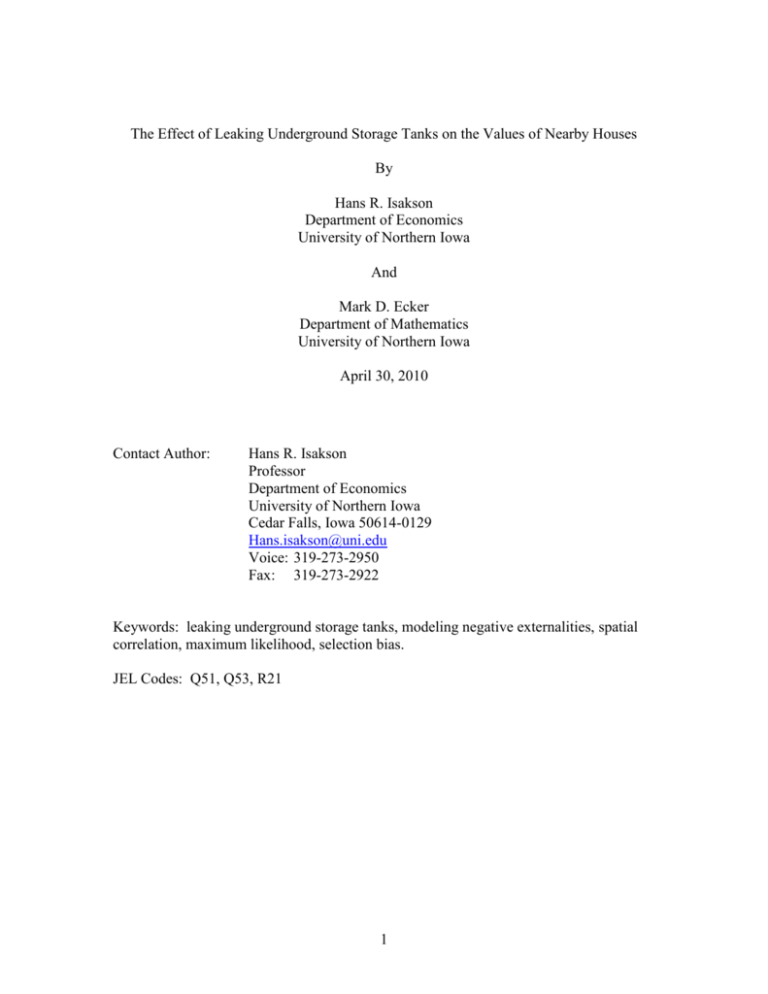
The Effect of Leaking Underground Storage Tanks on the Values of Nearby Houses By Hans R. Isakson Department of Economics University of Northern Iowa And Mark D. Ecker Department of Mathematics University of Northern Iowa April 30, 2010 Contact Author: Hans R. Isakson Professor Department of Economics University of Northern Iowa Cedar Falls, Iowa 50614-0129 Hans.isakson@uni.edu Voice: 319-273-2950 Fax: 319-273-2922 Keywords: leaking underground storage tanks, modeling negative externalities, spatial correlation, maximum likelihood, selection bias. JEL Codes: Q51, Q53, R21 1 Abstract This study examines the effects of proximity to a leaking underground storage tank (LUST) on housing values in a medium sized, Midwestern college city. This study builds upon the only other studies of this type of effect, (Simons, Bowen, and Sementelli (1997), Simons, Bowen, and Sementelli (1999), and Simons and Sementelli (1997)) by (1) using more detailed LUST data, (2) incorporating selectivity bias, (3) managing spatial effects, including spatial correlations, and (4) estimating all model parameters simultaneously using a state-of-the-art, unified, spatial-correlation estimation technique. The results suggest an aggregate negative impact of a low risk LUST of about $3 million. 2 The Effect of Leaking Underground Storage Tanks on the Values of Nearby Houses I. Introduction Leaking Underground Storage Tanks (LUSTs) are the source of serious contaminants that can penetrate the soil and be transported to nearby properties by various mechanisms. Since 1984, various federal and state laws have been enacted to address the remediation of LUSTs. Funding for administration and implementation of the laws designed to address the LUSTs problems comes from (1) a federal one cent per gallon tax on gasoline (LUST Trust Fund) and (2) similar state taxes that fund state LUST trust funds. Currently, a strong administrative structure at both the federal and state level regulates LUSTs. The major environmental problem produced by a LUST is contamination of nearby receptors, such as water wells, ground water aquifers, water lines, basements, sewers, and surface water. LUSTs found to be contaminating nearby receptors require remediation either by the owner or the state. Nationally, remediation costs average about $125,000 per LUST site (Tiemann, 2008). Because the contaminants are not directly visible or noticeable once they sink into the soil, prospective buyers and sellers of nearby properties rely on other indicators for gauging the potential effect of a LUST on property values. Of course, prospective buyers and sellers can search public files, such as those used in this study, for information regarding the location and riskiness of LUSTs. But, as a practical matter, there are other, less time consuming, techniques to discover this information. The above ground use of the LUST property acts as a proxy for the presence and riskiness of a nearby LUST. In urban areas, problematic LUSTs are found beneath gasoline stations. Two of the more 3 serious contaminants from a LUST (MTBE and ethanol) are common gasoline additives. So, the presences of a nearby gasoline station will tip-off potential buyers and sellers that a troublesome LUST might be under it. In addition, the appearance of the gasoline station can be a tip-off to the condition of the LUST under it. For example, we would expect more risky LUSTs to be found under older, less maintained gasoline stations. The condition of the pavement around the gasoline station can also act as a proxy for the riskiness of the LUST. In any event, just because the contaminants emitted by a LUST are not directly observable, does not mean that buyers and sellers will not know that a LUST is present or how risky living near the LUST might be. Thus, the extent to which housing prices reflect the proximity to and the proximity to and riskiness of a nearby LUST is an empirical matter. Once the impact on housing values of the proximity to and riskiness of the nearest LUST is estimated, an estimate of the aggregate impact on all of the properties surrounding a LUST can also be estimated using simple assumptions about the average density of housing. This aggregate estimate becomes important information for policy makers when assessing the benefits of any remedial or clean-up actions aimed at a particular LUST. Of course, the benefits of such efforts include protection/improvement of underground and surface water runoff. But, the benefits also include an external effect, namely the enhancement to the values of nearby properties. This external property enhancement feature should be factored into the cost-benefit analysis of any public decision regarding the containment or clear-up of a LUST. This study provides a framework that can be replicated elsewhere for factoring in this external effect. 4 This study examines the effects of proximity to a leaking underground storage tank (LUST) on housing values in a medium sized, Midwestern college city. This study builds upon the only other studies of this sort of effect, (Simons, Bowen, and Sementelli (1997), Simons, Bowen, and Sementelli (1999), and Simons and Sementelli (1997)) by (1) using more detailed LUST data, (2) incorporating selectivity bias, (3) managing spatial effects, including spatial correlations, and (4) estimating all parameters simultaneously in a state-of-the-art, unified, spatial-correlation modeling approach. The results demonstrate the importance of using the unified, spatial-correlation modeling approach developed in this study. The outline of the paper is as follows, section I contains the Introduction while section II is a review of the current literature on LUSTs. The data used in this analysis is detailed in section III while the formal statistical modeling is outlined in section IV. The model fitting and results can be found in section V, while the policy implications of the results can be seen in section VI. Lastly, section VII provides concluding remarks. II. Review of the Literature Studies of the impact on property values of proximity to a wide variety of negative and positive externalities abound in the literature. Jackson (2001) reviews over one hundred studies of the effects of various environmental contaminations on real estate. Simons and Saginor (2006) perform a meta-analysis of 58 peer reviewed journal articles that focus on externalities such as superfund sites, landfills, air and water pollution, pipeline ruptures, nuclear power plants, overhead transmission lines, views, parks, beaches, etc. In virtually all of the studies reviewed by these two seminal articles, proximity to a negative (positive) externality almost always adversely (positively) affects property values. 5 The literature addressing the effects of LUSTS on nearby property values is very scarce and uses the same LUST data (from Cuyahoga County, Ohio). Simons, Bowen, and Sementelli (1997) and Simons, Bowen, and Sementelli (1999) represent the sum total of efforts to examine the impact of LUSTs on nearby property values. Together, these two studies provide considerable insight into the impact of LUSTs (and non-leaking USTs) on property values in Cuyahoga County, Ohio (Cleveland). Although they do not look at the impact on nearby by property values, Simons and Sementelli (1997) report that (commercial) LUST sites suffer in terms of salability and financing, making them less than one-half as liquid (ability to convert into cash) than clean, comparable commercial sites in Cleveland, Ohio. Simons, Bowen, and Sementelli (1997) find about a 17% decline in the selling prices of 83 houses within 300 feet of a LUST in Cleveland, Ohio. Using the same data as their earlier study, Simons, Bowen, and Senmentelli (1999) report a 14% to 16% reduction in houses values within 300 feet of a gas station LUST. The Simon, Bowen, and Sementelli (1997) study uses a simple dichotomous variable to measure proximity to 527 known LUSTs (1 if within 300 feet, zero otherwise). The authors report deleting outliers using univariate plots of the housing related variables. They also report visually testing for heteroscedasticity using scatterplots of each variable against its own residuals and the model’s residuals. The authors performed two OLS regressions of selling price on a vector of housing characteristics, season of sale, and proximity to a LUST. Box-Cox type transformations on selling price, size, age, and lot frontage were performed in one OLS regression, while the other included un-transformed variables. Three different types of dichotomous proximity variables were included in the model: one for known leaking tanks not 6 currently registered, one for non-leaking tanks, and one for known and registered LUSTS. Only the coefficient for known and registered LUSTs was statistically significant. III. Data This analysis uses two distinct types of data: (1) housing sales data and (2) LUST data. The housing sales data consists of 2,079 single-family sales in Cedar Falls, Iowa.1 Initially, the sales dataset contained every transaction in the city of Cedar Falls from January 2000 to November 2004; these sales were parsed by using those identified as “arms length transactions” by the county tax assessor’s office. The time period was selected in order to avoid the contamination effects of the recent housing bubble. Additional refinement consisted of choosing only those sales with a selling price greater than $32,000 or less than $400,000, houses with at least three but less than 12 rooms, at least 500 square feet of living area, and a lot size less than 3 acres. Several homes were repeatedly sold in this time frame; so we used only the most recent sale to meet the requirements of the spatial component of our model. The Cedar Falls home sales data includes the following information (variables) for each of the 2,079 transactions: date of sale, state-plane coordinates of the centroid of the property, year built, lot size, living area, and number of rooms. In addition to these variables, we calculate the CBD distance from each property to downtown Cedar Falls. Table 1 shows the summary statistics for the 2,079 sales. Information for the 50 LUSTs in Cedar Falls was obtained from the Iowa Department of Natural Resources. Registration of underground storage tanks (USTs) is required by federal (40 CFR parts 280 and 281) and Iowa (Iowa Code 455.B.474) laws. 7 In Iowa all USTs, except certain small, residential USTs, must be registered with the Iowa DNR. These tanks must be inspected and assessed for their likelihood of contamination. If the site containing the UST has evidence of contaminants that do not exceed certain maximum levels, then it is classified as requiring no further action. If the onsite contaminants exceed the maximum levels, but no receptors (water wells, aquifer, plastic water lines, basement, sewers, or surface water) are within its transport plum, then it is rated as a Low Risk LUST and must be tested annually. If receptors exist within the transport plum of the contaminants, then it is classified as a High Risk LUST and faces more intensive monitoring, testing, and possible remediation. Figure 1 shows the location of all 2,079 sales together with the 50 LUSTS in Cedar Falls. The risk level of each LUST is indicated in Figure 1 with different sized boxes. Six of the LUSTs are classified as High Risk, four were classified as Low Risk, and the remaining 40 are classified as no further action required. For each sale, we include a proximity variable (the minimum distance to the nearest LUST) and an ordinal intensity variable (the level of action required for the nearest LUST – None, Low Risk or High Risk). The LUST variables are discussed in greater detail in the next section. IV. Modeling The model in this study consists of three primary ingredients: (1) the mean structure of the model, (2) the structure of the error term, and (3) testing and correcting for selection bias. The mean structure of the model is basically the same as similar studies of house prices. The error term is structured to model the presence of spatially correlated data. The potential for and correction of selection bias is modeled into both the mean and error 8 structures of the model. Appropriate statistical methods are used to fit the model using the sales and LUSTs data. The Mean Structure The mean structure of the model contains several layers of explanatory variables typically thought to explain home prices. Most broadly, these layers include (1) site level nonspatial characteristics of the home (house size characteristics including living area, number of rooms, parcel size, year built, and time of sale), (2) spatial characteristics (distance to nearby destination points), (3) LUST level factors (such as distance to the nearest LUST; riskiness of the nearest LUST), and (4) a selection bias factor (the number of LUSTs within a certain radius from each sale). Specifically, let P = the selling price of the house, S = lot size in acres, t = the time of the sale, C = a vector of site level non-spatial characteristics of the house that typically affects selling price, S = a vector of site level spatial measures of proximity to destination points, L = LUST level factors (distance to the nearest LUST and the riskiness of the nearest LUST), CT = the number of LUSTSs within 0.25 miles of the home, then the selling price of a house can be modeled as, P S e t C SL CT (1) where the Greek letters represent parameters of the model which will be estimated using the sales and LUSTs data. Note that , , and represent scalar parameters while 9 ., and represent, potentially, vectors of parameters. On the natural log scale, the model (1) becomes: ln P ln( S ) t C S L CT (2) The LUSTs Variables The modeling of the LUST effect in this study is very different than in Simon, Bowen, and Sementelli (1997). Simon, Bowen, and Sementelli (1997) use a series of three dichotomous variables representing the three classifications of LUSTs in their study: (1) sale within 300 feet of a leaking, unregistered tank, (2) sale within 300 feet of a registered UST, not leaking, and (3) sale within 300 feet of a leaking and registered tank. Simon, Bowen, and Sementelli report that although the extent of the leaks in a LUST is important, information about the extent of the leaks were not available to them. The LUSTs in the Simon, Bowen, and Sementelli study appear to be less densely distributed than in this study. Simon, Bowen, and Sementelli report 83 out of 16,990 (0.49%) sales occurring over a five year period being within 300 feet of the nearest UST. In this study, we find only 19 out of 2,079 (0.91%) of the sales within 300 feet of the nearest LUST. However, 19 sales is far too small a number to replicate the Simon, Bowen, and Sementelli use of three dichotomous LUST variables. Therefore, we use a different approach to modeling the LUST effect. First, this study has the advantage of LUST data that includes information beyond the location of the LUST, namely the risk that the LUST contaminates nearby receptors. The LUST data in this study includes an assessment of the riskiness (described in the previous section) of the LUST to nearby properties. In this study, the riskiness of the nearest LUST is captured by an ordinal variable (0 = no action required, 1 = annual 10 testing required, or 2 = requires further study and/or remedial action), while proximity is measured as the distance to the nearest LUST. The parameter of the ordinal, riskiness variable captures the impact of the LUST on properties located immediately adjacent to it (distance away from it is zero). Second, this study makes use of a cardinal variable to measure the proximity of each sale to the nearest LUST. The parameter of this variable tells us how fast the LUST effect decays with distance away from it. The combination of the two LUST variables allows us to estimate, given the density of housing, the aggregate impact of the LUST on all of its surrounding houses. This aggregate effect gives public officials one more tool for factoring into their decision whether or not to require removal of the LUST and cleanup of the site. Structure of the Error Term Standard Ordinary Least Squares (OLS) regressions assume ~ N (0, 2 ) where normality and constant variance ( 2 is a variability parameter, after accounting for all values of the covariates) is assumed. When dealing with spatial data, such as housing sales and the LUSTs data, the potential exists for the OLS parameter estimates to be biased. Examination of the OLS residuals in (2) reveals the presence of spatial correlations. Therefore, efforts must be undertaken to remove this source of bias. Spatial linear models (see Cressie (1993); Isakson and Ecker (2001); and Ecker (2003)) assume that the errors are not independent, that is, two comparable homes that are closer in space sell for a much more similar price than two comparable homes farther apart. Specifically ~ N (0, 2 2 ) 11 (3) where 2 is called the “nugget” , i.e. a micro-scale or measurement error variability, in the geostatistical literature (see Cressie 1993). The sum 2 2 in (3) is termed the spatial variability of the spatial process or “sill”; it is the variability of the home prices after adjusting for individual home characteristics. Lastly, for two home sales with errors i and j , their spatial correlation is modeled as a function of their Euclidean distance apart, d ij . Specifically, we adopt the exponential correlation structure, i.e, Corr(ln( i ), ln( j )) exp( dij ) . (4) The parameter directly controls the spatial correlation in the dataset and is termed the “range” (technically 3 is the exact value of the range (see Ecker 2003) for the exponential correlation structure). Thus, any two homes that are separated by a distance of more than the range, have selling prices that are essentially uncorrelated. Spatial correlation models, (3) and (4), are random effects models designed to capture extra variability not explained in the mean structure in equation (1). Spatial correlation models can help mitigate the impact of missing or incorrectly specified variables from the analysis. Selection Bias If LUSTs and lower priced homes are clustered together, the result could be due to selection bias, i.e, the low land prices attract LUST owners as well as home buyers looking for inexpensive sites. An attractive methodology to explore selection bias is to examine house sales just before and right after a tank has been determined to be leaking. Unfortunately, such study is impractically difficult and time consuming. In the present study, selection bias is investigated primarily by including a variable (Count) in 12 the mean structure of the model to capture the extent of LUST clustering. This study includes for each sale, the count or number of LUSTSs within a very close, 1/4 mile distance of each sale. Note that 584 of the 2,079 (28.1% ) Cedar Falls sales have at least one LUST within a quarter mile and one home had eight LUSTs within a quarter mile. If selection bias were present in this dataset, then one would anticipate more LUSTSs located geographically closer to lower valued homes (than located near higher-valued home), i.e., the count variable would be statistically significant and negative. V. Model Fitting and Results An OLS regression is initially fit to the Cedar Falls home sales data. The results are given in the first column of Table 2. The house specific size variables of Living Area, Number of Rooms and Parcel Size are all positive and strongly significant. As expected, bigger houses sell for more. Year built is positive and significant; new houses sell for more. Date sold is positive and significant; we have a 4.73% annual rate of appreciation over the 4 years of sales. Distance to downtown Cedar Falls is negative and significant, indicating that it is more desirable to live near downtown (Cedar Falls has had a main street revitalization initiative with many small businesses locating downtown). Minimum distance to the nearest LUST is positive and significant; not surprisingly, it is less desirable to buy a house close to a LUST. Condition is strongly significant and negative; the more risky the tank, the less desirable it is to live near it. Lastly, the selection bias, count variable is negative and marginally significant (p-value = 0.0714) thus giving some evidence of selection bias. The more LUSTS within a quarter mile of the house sale, the lower are the value of the houses. 13 To determine if a geostatistical, spatial model is appropriate for the Cedar Falls home sales data, we look at the residuals from the OLS regression. An empirical variogram is constructed (see Figure 2). The sharp drop-off near the origin indicates that houses are more similar (less variability) as separation distances between a pair of houses decreases, i.e, spatial correlation is present in the Cedar Falls home data. Thus, the OLS model is inferior to one which incorporates the spatial correlation. To fit the Spatial Linear Model in SAS, seed values are required for the spatial parameters, range, sill and nugget. These are easily provided via the S-Plus procedure to fit a theoretical variogram to the empirical variogram from the residuals from the OLS regression. Figure 2 displays the fit of the empirical variogram to the residuals, and the seed values from the empirical variogram are reported at the bottom of the OLS column in Table 2. The results from the Spatial Linear Model fit using Proc Mixed in SAS are shown in the second column in Table 2. The site-specific variables: Living Area, Date Sold, Year Built, Number of Rooms and Parcel Size retained their statistical significance and interpretations from the OLS regression. The Distance to Cedar Falls variable also was significant at the 0.05 level; although its p-value has crept up from 0.0195 to 0.0441. Distance to the nearest LUST and condition of the nearest LUST remain important factors in determining a home’s value, although the condition variable has had its (partial) slope value almost cut in half. Lastly, the Count variable has moved from being moderately significant to being insignificant. The spatial association parameters from the SAS Proc Mixed results are provide in Table 2. Notice that the range parameter has dropped from 0.0733 miles to 0.0230. Thus parcels separated by 0.023 miles (120 feet) are spatially correlated. The change in 14 the range parameter illustrates how simultaneous estimation of all model parameters (via Proc Mixed in SAS) affects the initial model where spatial correlation is measured sequentially, after the OLS regression has been fit. Lastly, the sharp change in the count variable indicates the sensitivity to the mean structure parameters, both not including and incorporating a spatial correlation effect. If spatial correlation is present, it needs to be fitted simultaneously with the mean structure parameters to avoid biased estimates. VI. Discussion and Policy Implications The results of this study indicate that a house immediately adjacent to one of the riskiest LUSTs suffers about a 11 percent (about $14,950) reduction in value compared to the same house located outside the range of influence of the LUST. This negative effect is half this size for a low risk LUST. The negative external effect of proximity to a LUST decays to zero very rapidly; the radius of influence of a low risk LUST is about .338 miles or 1,787 feet. About 230 acres of land is included within this radius. With about 25 percent of the land used as streets and rights-of-way to streets plus the average lot size in this study (0.265 acres), about 650 houses might suffer a reduction in value. If we further assume that about one-third of the houses are lost to other land uses, such as parks, open spaces, larger than average lots, etc., a conservative, aggregate impact of the less risky LUST is about $3 million. This estimate would be doubled for a high risk LUST. Given the average cost of remediating a LUST of $125,000, the benefits seemingly outweigh the costs by a considerable margin. However, the enhancement of the value of surrounding houses would require that the above ground land use of the LUST site be equivalent or better than the above ground land use of LUSTs with no risk. This extension of the findings of this study suggest that the remediation of risky LUSTs 15 in urban areas may well be worth the effort, especially if attention is also devoted to the improving the above ground land use of the site. VII. Summary and Conclusions This study extends the work of the previous studies of the impact on housing values of proximity to a LUST by (1) using more detailed LUST data, (2) incorporating selectivity bias, (3) managing spatial effects, including spatial correlations, and (4) estimating all parameters simultaneously in a state-of-the-art, unified, spatial-correlation modeling approach. The results demonstrate that the simultaneous estimation technique used in this study corrects for the significant spatial correlations found in housing sales data. The results confirm the previous studies findings that proximity to a LUST does adversely affect the value of nearby houses and that this adverse effect decays rapidly with distance from the LUST. We found that the maximum impact on a house adjacent to a very risky LUST is about 11 percent and about 5.5 percent for a less risky LUST. We also found that this adverse effect disappears about one-third of a mile away from the LUST. Yet, even for the modestly priced houses in this study, the dollar impact of the LUST effect is sufficient to warrant remedial actions. This study, as the previous studies, assumes that the transmission mechanism for the negative externality created by proximity to a risky LUST is the use and condition of the use of the site. The implication is that in order to remove the adverse LUST effect from nearby houses, the remediation effort should also address the remaining use and condition of the site. The LUST site must be remediated at least to the level of a LUST site that requires no further action, in order for nearby houses to realize any relief from the negative externality created by the LUST. 16 VIII. References Cressie, N (1993). Statistics for Spatial Data. New York: John Wiley and Sons. Ecker, M.D. (2003). Geostatistics: Past, Present and Future. In Encyclopedia of Life Support Systems (EOLSS) . Developed under the Auspices of the UNESCO, EOLSS Publishers, Oxford, UK. [available at: www.eolss.net]. Isakson, H. and Ecker, M.D. (2001). An Analysis of the Influence of Location in the Market for Undeveloped Urban Fringe Land. Land Economics, 77(1): 30-41. Jackson, T.O. (2001). The effects of environmental contamination on real estate: A literature review. Journal of Real Estate Literature, 9(2): 91-116. Simons, R.A. and Saginor, J.D. (2006). A meta – analysis of the environmental contamination and positive amenities on residential real estate values. Journal of Real Estate Research, 28(1/2): 71-104. Simons, R.A., Bowen, W.M, and Sementelli, A.J. (1997). The effect of underground storage tanks on residential property value in Cuyahoga County, Ohio. Journal of Real Estate Research, 14 (1/2): 29-42. Simons, R.A. and Sementelli, A.J. (1997). Liquidity loss and delayed transactions with leaking underground storage tanks. Appraisal Journal, July, 255-260. Simons, R.A., Bowen, W.M. and Sementelli, A.J. (1999). The price and liquidity effects of UST leaks from gas stations on adjacent contaminated property. Appraisal Journal, April, 186-194. Tiemann, M, (2008). Leaking underground storage tanks: Prevention and cleanup. Congressional Research Service (RS21201), The Library of Congress. 17 Figure 1 : Cedar Falls sales (o) and LUSTs (■) locations. 367 Y 366 365 364 No Action Required Low Risk High Risk 363 519.0 519.5 520.0 520.5 X Note: Plot is in State Plane Coordinates 18 521.0 521.5 Table 1 Summary Statistics of Cedar Falls sales data with N=2,079 Variable Mean Std Dev Minimum Maximum Sales Price $144,995 71,415 $32,500 $399,500 523.6 1865 4 0.071 3625.6 2003 11 2.254 Structural: Living Area Year Built N. Rooms Lot Size 1332.7 sq feet 1960.6 5.855 0.265 acres 489.7 28.5 1.429 0.155 Time: Date of Sale 2.562 1.387 0.005 4.885 Distance to: Cedar Falls 3.430 miles 1.174 0.165 6.037 LUST Level: Min Distance Condition Count (1/4 mile) 0.484 miles 0.195 0.641 0.309 0.574 1.292 0.017 0 0 19 1.832 2 8 Table 2: SAS results for Cedar Falls sales data. Min Distance Count Condition Distance to CF Ln Living Area Date Sold Year Built Number of Rooms Ln Parcel Size Nugget Sill Range OLS 0.0717 (0.0011) -0.0079 (0.0714) -0.1006 (0.0001) -0.0115 (0.0195) 0.4296 (0.0001) 0.0473 (0.0001) 0.0061 (0.0001) 0.0874 (0.0001) 0.1385 (0.0001) 0.0248 0.0451 0.0733 20 Proc Mixed 0.1663 (0.0001) -0.0006 (0.9440) -0.0563 (0.0015) -0.0206 (0.0441) 0.3666 (0.0001) 0.0531 (0.0001) 0.0052 (0.0001) 0.0689 (0.0001) 0.0861 (0.0001) 0.0045 0.0528 0.0230 0.02 0.01 0.0 gamma 0.03 0.04 Figure 2 : Exponential Variogram model fit to the Empirical Variogram created from the OLS residuals for the Cedar Falls sales data. objective = 0.0001 0.0 0.1 0.2 0.3 distance 21 0.4 0.5 1 The authors thank the Black Hawk County Board of Supervisors for providing the house sales data used in this study. The opinions expressed in this paper should not be interpreted as representing the opinions of the Black Hawk County Board of Supervisors. 22


